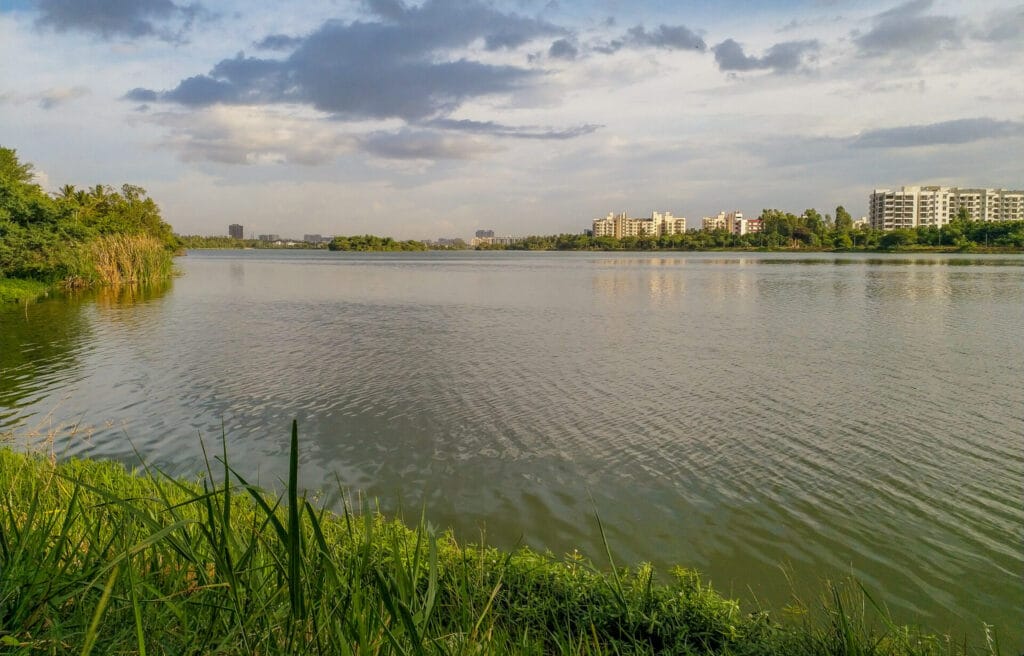The following is an excerpt from the book Shades of Blue: Connecting the drops in Indian cities, written by Harini Nagendra and Seema Mundoli, and published by Penguin Random House India. The excerpt is from the chapter: Bengaluru: Landlocked city of tanks and lakes and has been republished with permission from the authors and publisher:
To know where a lake once was, Bengaluru has only to wait for the monsoon. The Kempegowda Bus Stand, the Sri Kanteerava Stadium, the hockey stadium in Akkithimmanahalli in the city and the Asian Games Village in Koramangala, all of which are sites of former lakes, become flooded. With many of the channels that connected these lakes built on, or filled with garbage, water flows onto the road and into offices and homes, throwing parts of the city into chaos for weeks.
Meanwhile, planners, politicians, real estate honchos and corporate giants begin a ritual blame game, each tossing the ball of responsibility to the other. In the end, nothing changes—only wait, it does! Things get worse, year after year.
With the effects of climate change already being felt, Bengaluru faces an uncertain future of intense floods interspersed with long periods of drought. The city is seeking a new paradigm, a new imagination of how to live with water.
Bengaluru is well known in India for the citizen activism that has led to the revival of many once- degraded lakes, contributing to the physical and mental health of lakhs of people who visit these public spaces to walk, jog and connect with nature in the city.
Civic groups and local residents have taken to the streets in protest, engaged in signature campaigns, used social media and filed public interest litigations (PILs) to push for lake restoration. However, many restored lakes disallow traditional users whose ancestors once maintained these lakes, including grazers, fishers and fodder collectors. While the restored lake becomes a location for walking and jogging along well-defined paths, those who depended on the lake for food and livelihoods are alienated.
Read more: Chasing Soppu: A guide to wild edible plants in Bengaluru
Signs of hope are beginning to emerge amidst the tales of gloom and doom. Several of the successfully restored lakes in Bengaluru, including Jakkur and Kaikondrahalli, are challenging this paradigm of lake restoration by enclosure. The lake groups here are working with fishers and grazers in innovative ways and lobbying with the municipal government to change their restrictive policies. So are civic organizations like the Environment Support Group, whose landmark PILs have helped provide legal protection for the lakes in the city. Recent efforts at the restoration of kaluves and wells in parts of the city, though very nascent, are also promising.
When Bengaluru was first populated, scattered lakes were first created, and then interconnected to form a living system. So too can these diverse, dispersed initiatives, if they connect and gather force. Then we can see Bengaluru return to being a kalyana nagara, city of lakes, once again.
Origin myths of lake formation
Bellandur, Bengaluru’s largest lake, has an origin myth told by many, including the priestess of the Dugalamma Temple on the lake bund. In one version, the location where the lake now exists was once a banana plantation. The goddess, Dugalamma, came in the guise of a pregnant woman (in another version of the tale, an elderly woman) who asked the owner and others for a banana (in another version, for a plantain leaf to use as a plate). When her request met with refusal, the angry Dugalamma invoked a heavy rainfall that submerged the entire plantation, creating the lake that exists today, only stopping the rains when the village built a temple to her. Another origin story tells us that the lake was created in gratitude for an act of kindness, when someone offered water to a thirsty woman (the goddess in disguise). As a blessing, she converted the fallow land into the lake.
These two myths encapsulate the identity of water—a blessing in times of drought and a curse when it floods.
About the book
For millennia, our cities have prospered and grown in the cradles of civilization-fertile lands blessed with rivers, lakes, seas and oceans. From the origins of life on earth, right down to its downfall, biblical or otherwise, water has been integral to the human story.
In this passionate and extensively researched tribute to the elixir that sustains us all, authors Harini Nagendra and Seema Mundoli take us on a panoramic view of the water bodies of India and the urgent need to address their emergent ecological threats. From the Yamuna in Delhi to the Cauvery in Karnataka and the Pichola Lake in Udaipur to the Brahmaputra in Assam, this book is epic in its sweep and yet deeply moving in its intimate concerns.
Interspersed with anthropological, legal and scientific vignettes of the water are fascinating anecdotes, ditties, myths and monsters blue and green. This book also brings into dialogue a vast range of colourful characters-from medieval poets to colonial masters and modern scientists-to paint for us a tapestry of connected histories and ring a timely knell for saving the very ecological systems that have sustained us for ages.
Note: All copyrights belong to the publisher.

